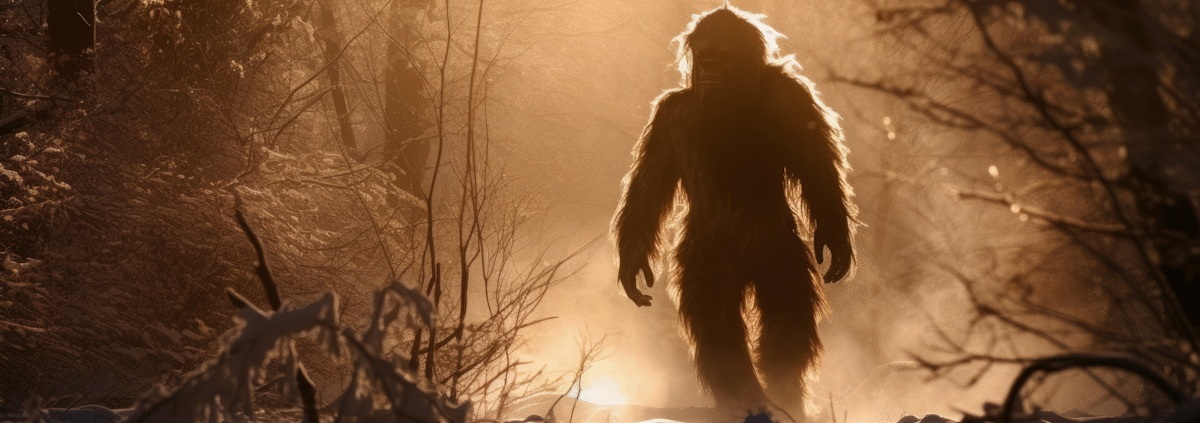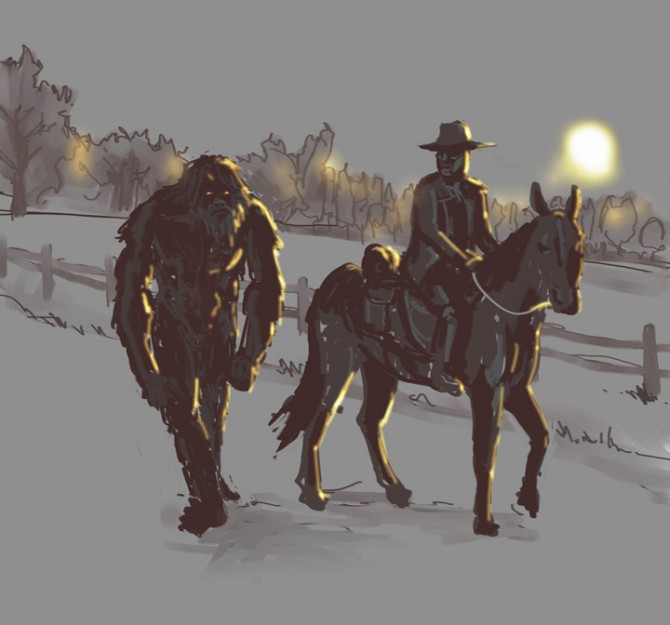The Hairy Man of Hebron
Shoal Creek, the far southwest Utah location that became the settlement called Hebron, was sought after for its tall grasses. Though not abundant, it became something of an oasis in the desert for those keeping sheep.
Our family connection to Shoal Creek is through Edwin Westover, who was called to serve a mission for the Church herding sheep in the Cotton Mission.
Edwin’s experience there was not great. Living with two wives in abject poverty the family was tasked with running a Church ranch. While there, Edwin and his 2nd wife Ann Finley had their 3rd child, a daughter named Mary Ellen.
As documented in the video we long ago produced about Edwin’s life, it was at Hebron that the Thomas Fuller affair occurred and the Westover family became disaffected with local church leadership led by the Pulsipher family.
As it turns out, Hebron was not destined to be a peaceable place for many others as well. Many other locals suffered from contentious relationships and even demonic possession.
To Native American populations with a history in Southwest Utah the legends of the area led them to believe it was something of a cursed place.
In their passed down histories it was a battleground, where righteous warriors fought against the forces of Gadianton robbers of Book of Mormon history.
Among the legends were tales of giants and especially of a roaming Hairy Man – a lone, wandering figure of misery.
~ Mormon Lore of Cain ~
Today he is widely known as Bigfoot – an elusive figure seen in various locations of the Pacific Northwest.
He is described as being taller than 9 feet with dark skin and hairy all over. He does not wear clothes because his prolific hair is sufficient to cover him.
Many on the Internet claim LDS beliefs about Cain, the murderous son of Adam, became the tortured figure we now call Bigfoot.
While the Biblical account of the first murder is instructive it hardly connects Cain to becoming Bigfoot.
Though thoroughly taught the gospel by his parents, Cain “loved Satan more than God.” He became rebellious, “carnal, sensual, and devilish.” Cain was to become the father of Satan’s lies and to be called perdition.
His culminating sin was the murder of his brother Abel, which he did by secret covenant with Satan and to gain Abel’s possessions.
As a punishment the Lord consigned the wicked Cain to be a fugitive and a vagabond and placed a mark upon him which would reveal his identity.
So how has Cain become associated with Bigfoot?
Thanks to an unconfirmed story attributed to earlier LDS apostle David W. Patten in 1835 Mormons have known about “Bigfoot” for generations – even before coming to Utah:
“As I was riding along the road on my mule, I suddenly noticed a very strange personage walking beside me. He walked along beside me for about two miles. His head was about even with my shoulders as I sat in my saddle. He wore no clothing, but was covered with hair. His skin was very dark. I asked him where he dwelt, and he replied that he had no home, that he was a wanderer in the earth and traveled to and fro. He said he was a very miserable creature, that he had earnestly sought death during his sojourn upon the earth, but that he could not die, and his mission was to destroy the souls of men. About the time he expressed himself thus, I rebuked him in the name of the Lord Jesus Christ and by virtue of the Holy Priesthood, and commanded him to go hence, and he immediately departed out of my sight.’”
Please note that this story was published in 1900, decades after Patten had died during the Battle of Crooked River in Missouri in 1838. So, this isn’t exactly history.
The story has never been confirmed via official records or doctrine of the Church of Jesus Christ of Latter-day Saints, but it has persisted along side the legends of the Three Nephites, even during the generations of Edwin and Ann Westover.
Most certainly the legend of a giant hairy creature was known in Shoal Creek/Hebron because local Indians warned settlers of sightings of him in area mountains.
Mountains, in fact, even today seem to be central to alleged Bigfoot sightings.
In nearly every decade of known history the legend of Bigfoot has been noted in mountains from north to south in Utah.
His reality – or myth – has been perpetuated over time and by many people.
~ Bigfoot of Washington City ~
Some 50 miles northeast of Hebron is the city of Washington, Utah – where Edwin’s brother Charles lived with his families and with their Mother, Electa Westover.
In that city lived a man with a legendary name – Ithamer Thomas Sprague.
Ithamer pulled one of the greatest bigfoot hoaxes on the pioneer city of Washington in the 1870s.
Ithamer Sprague built a pair of huge “clodhoppers” and one night he put them on and left gigantic human footprints on the dusty village streets.
News of the mysterious prints spread quickly through town. Some residents laughed and dismissed them as the work of a prankster. Others believed a huge creature was actually stalking the village.
Sprague left tracks again on following nights. More and more townsfolk became convinced that a mysterious, ferocious being had begun to plague the town. Local Paiutes only added to the unrest when they told stories of a legendary giant who had once prowled that region, killing and plundering the countryside.
Sprague laughingly continued his prank. Residents began blaming mishaps on the mysterious beast: the hens were too frightened to lay, the milk soured too soon, and one lady had a miscarriage due to her fright. Search parties tried to capture the monster, but the tracks always either disappeared abruptly or led to rocks where they were no longer traceable.
One night, Ithamer snuck out of a dance, put on his huge shoes, stalked through the village, then returned to the dance. At intermission, Ithamer and friends went outside for a drink, and Ithamer spotted the fresh tracks.
A crowd gathered. People grabbed their weapons and set out to capture the giant–which they were sure was close by. But again the shoe prints disappeared in some rocks.
Several versions of how the town learned of Sprague’s hoax evolved over the years. According to one version, the town met together and discussed deserting the village or sending a messenger to Brigham Young to ask for advice.
During the meeting a girl whom Sprague had been courting noticed his smug attitude and told him to confess. He asked her what she would do if he did admit to being the prankster. She replied that she would finally consent to marrying him. According to this story, Sprague excitedly jumped to his feet and confessed, and the couple got married shortly thereafter.
In another version, Sprague and another man were going to cut wood in the mountains. But the man’s wife refused to let him go, fearing the giant. In order not to have to cut the wood alone, Sprague confessed his prank.
However the truth came out, the townsfolk told the story so often that Ithamer Sprague became something of a legend — and the area’s most beloved prankster.
~ Realities from Legends and Myths ~
There are telling truths to be gleaned from fun stories like the prankster in Ithamer Sprague or the legend of David Patten.
Even from the tales of Indian folklore we can learn something.
The recorded history of Hebron shows that local Paiute tribes welcomed the Mormons as neighbors but warned that the land of Shoal Creek had a deeply spiritual past.
For the Paiutes the “hairy man” was a spiritual entity as much as was his imposing physical reality.
Paiute legends feature the Si-Te-Cah, or “tule eaters,” a race of red-haired, cannibalistic giants who were driven into Lovelock Cave and destroyed by the Paiute. While described as a warlike people, their story has also been likened to Bigfoot legends, with some believing they were a prehistoric, giant ape-like being. Mainstream archaeology views the tales as myth, but discoveries in Lovelock Cave have fueled speculation about the Si-Te-Cah’s existence.
They were enemies of the Paiute ancestors and were eventually driven into Lovelock Cave.
For those in the area of Hebron sometimes local natives would see “the hairy man” in the mountains – or the large tracks he left behind – because they claimed he was there to protect the graves of his fallen Gadianton ancestors or he was there to honor their memory.
When local Church congregants in the late 1860s began a documented run-in with evil spirits the local natives claimed the Gadianton enemies of their ancestors wanted not only the possession of pioneer souls but the return of their lands.
If you research Bigfoot you are sure to find a lot. He’s been seen most famously in California, Oregon, and Washington. But Utah, thanks to our Mormon connections, continues to highlight the list, even in modern times.
It is interesting to note, in our quest of family history, that a legend like Bigfoot finds a place.
Does it matter? Can it be explained?
No, of course not. But it is certainly something we can ask about when we get to the other side.




Leave a Reply
Want to join the discussion?Feel free to contribute!